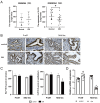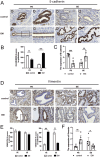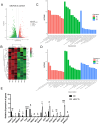Loss of KLF15 impairs endometrial receptivity by inhibiting EMT in endometriosis
- PMID: 38513352
- PMCID: PMC11056958
- DOI: 10.1530/JOE-23-0319
Loss of KLF15 impairs endometrial receptivity by inhibiting EMT in endometriosis
Abstract
The impaired endometrial receptivity is a major factor contributing to infertility in patients with endometriosis (EM), but the underlying mechanism remains unclear. Our study aimed to investigate the role of Kruppel-like factor 15 (KLF15) in endometrial receptivity and its regulation in EM. We observed a significant decrease in KLF15 expression in the mid-secretory epithelial endometrial cells of EM patients compared to normal females without EM. To confirm the role of KLF15 in endometrial receptivity, we found a significantly reduced KLF15 expression and a significant decrease in embryo implantation number in the rat model via uterine horn infection with siRNA. This highlights the importance of KLF15 as a regulator receptivity. Furthermore, through ChIP-qPCR, we discovered that the progesterone receptor (PR) directly binds to KLF15 promoter regions, indicating that progesterone resistance may mediate the decrease in KLF15 expression in EM patients. Additionally, we found that the mid-secretory endometrium of EM patients exhibited impaired epithelial-mesenchymal transition (EMT). Knockdown of KLF15 upregulated E-cadherin and downregulated vimentin expression, leading to inhibited invasiveness and migration of Ishikawa cells. Overexpression KLF15 promotes EMT, invasiveness, and migration ability, and increases the attachment rate of JAR cells to Ishikawa cells. Through RNA-seq analysis, we identified TWIST2 as a downstream gene of KLF15. We confirmed that KLF15 directly binds to the promoter region of TWIST2 via ChIP-qPCR, promoting epithelial cell EMT during the establishment of endometrial receptivity. Our study reveals the involvement of KLF15 in the regulation of endometrial receptivity and its downstream effects on EMT. These findings provide valuable insights into potential therapeutic approaches for treating non-receptive endometrium in patients with EM.
Keywords: KLF15; endometrial epithelial; endometriosis; endometrium receptivity; epithelial–mesenchymal transition.
Conflict of interest statement
The authors declare that there is no conflict of interest that could be perceived as prejudicing the impartiality of the study reported.
Figures









Similar articles
-
Role of epithelial-mesenchymal transition regulated by twist basic helix-loop-helix transcription factor 2 (Twist2) in embryo implantation in mice.Reprod Fertil Dev. 2019 Apr;31(5):932-940. doi: 10.1071/RD18314. Reprod Fertil Dev. 2019. PMID: 30779884
-
ZEB1 modulates endometrial receptivity through epithelial-mesenchymal transition in endometrial epithelial cells in vitro.Biochem Biophys Res Commun. 2020 May 7;525(3):699-705. doi: 10.1016/j.bbrc.2020.02.153. Epub 2020 Mar 2. Biochem Biophys Res Commun. 2020. PMID: 32139122
-
Polychlorinated biphenyls impair endometrial receptivity in vitro via regulating mir-30d expression and epithelial mesenchymal transition.Toxicology. 2016 Jul 15;365:25-34. doi: 10.1016/j.tox.2016.07.017. Epub 2016 Jul 29. Toxicology. 2016. PMID: 27481218
-
Alterations in Epithelial Cell Polarity During Endometrial Receptivity: A Systematic Review.Front Endocrinol (Lausanne). 2020 Oct 27;11:596324. doi: 10.3389/fendo.2020.596324. eCollection 2020. Front Endocrinol (Lausanne). 2020. PMID: 33193109 Free PMC article.
-
The role of mesenchymal-epithelial transition in endometrial function.Hum Reprod Update. 2019 Jan 1;25(1):114-133. doi: 10.1093/humupd/dmy035. Hum Reprod Update. 2019. PMID: 30407544 Review.
Cited by
-
Krüppel-like factors family in health and disease.MedComm (2020). 2024 Sep 10;5(9):e723. doi: 10.1002/mco2.723. eCollection 2024 Sep. MedComm (2020). 2024. PMID: 39263604 Free PMC article. Review.
-
Endometrial E-cadherin and N-cadherin Expression during the Mid-Secretory Phase of Women with Ovarian Endometrioma or Uterine Fibroids.J Pers Med. 2024 Aug 29;14(9):920. doi: 10.3390/jpm14090920. J Pers Med. 2024. PMID: 39338174 Free PMC article.
-
The SOX18-OTUB1-YAP1 axis: a new endometriosis target.J Transl Med. 2025 Jun 11;23(1):647. doi: 10.1186/s12967-025-06677-y. J Transl Med. 2025. PMID: 40500704 Free PMC article.
-
[Establishment of a predictive nomogram for clinical pregnancy rate in patients with endometriosis undergoing fresh embryo transfer].Nan Fang Yi Ke Da Xue Xue Bao. 2024 Jul 20;44(7):1407-1415. doi: 10.12122/j.issn.1673-4254.2024.07.21. Nan Fang Yi Ke Da Xue Xue Bao. 2024. PMID: 39051087 Free PMC article. Chinese.
References
-
- Anupa G Sharma JB Roy KK Sengupta J & Ghosh D. 2019An assessment of the multifactorial profile of steroid-metabolizing enzymes and steroid receptors in the eutopic endometrium during moderate to severe ovarian endometriosis. Reproductive Biology and Endocrinology 17111. (10.1186/s12958-019-0553-0) - DOI - PMC - PubMed
-
- Buck VU Kohlen MT Sternberg AK Rosing B Neulen J Leube RE & Classen-Linke I. 2021Steroid hormones and human choriogonadotropin influence the distribution of alpha6-integrin and desmoplakin 1 in gland-like endometrial epithelial spheroids. Histochemistry and Cell Biology 155581–591. (10.1007/s00418-020-01960-z) - DOI - PMC - PubMed
MeSH terms
Substances
LinkOut - more resources
Full Text Sources
Medical
Molecular Biology Databases
Research Materials

